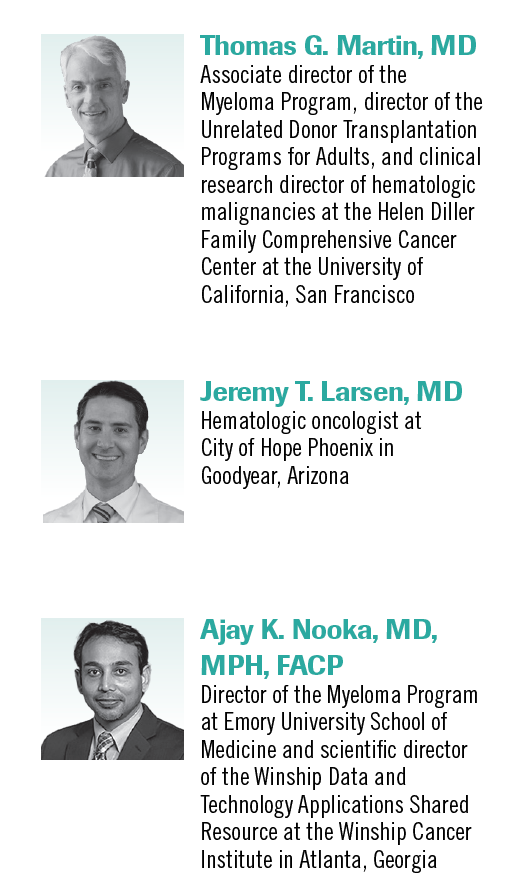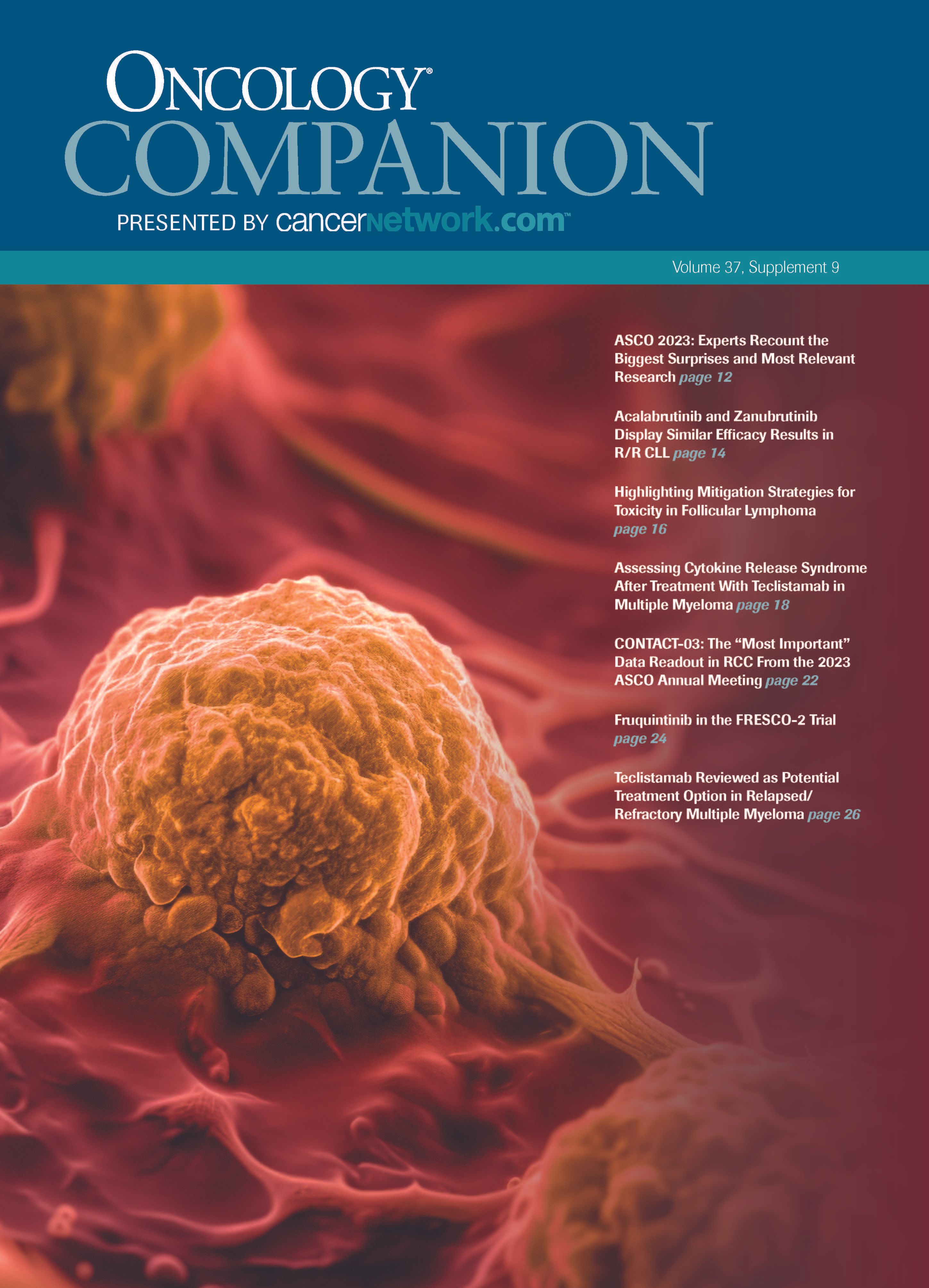Assessing Cytokine Release Syndrome After Treatment With Teclistamab in Multiple Myeloma
Thomas G. Martin, MD, discussed with his colleagues cytokine release syndrome after treatment with teclistamab for patients with multiple myeloma.
Thomas G. Martin, MD, discussed with his colleagues cytokine release syndrome after treatment with teclistamab for patients with multiple myeloma.

During a recent Between the Lines program hosted by CancerNetwork, an expert panel discussed the prevalence of cytokine release syndrome (CRS) among patients with relapsed/refractory multiple myeloma enrolled in the phase 1/2 MajesTEC-1 study (NCT03145181; NCT04557098) who were treated with teclistamab (Tecvayli).1 The moderator was Thomas G. Martin, MD, who spoke with colleagues Jeremy T. Larsen, MD, and Ajay K. Nooka, MD, MPH, FACP.
The panel discussed their practices regarding the diagnosis and management of CRS and how these new data may affect their current standard of care. They also spoke about the use of tocilizumab (Actemra) to manage CRS, including as prophylaxis, and the landscape of treatment options in this disease space overall.
The Diagnosis and Grading of CRS
Nooka and Larsen kicked off the discussion on the diagnosis and grading of CRS. Larsen noted that it can occur with any of the T cell–directed therapies, including teclistamab, and that its prevalence is increasing in those treated with bispecific therapies as well. He noted that fever, hypertension, and anything resembling sepsis among patients receiving T-cell–directed therapy should be recognized as CRS.
In terms of severity, grade 3 or 4 CRS is relatively uncommon; the toxicity most often presents as grade 1 or 2, according to Larsen, which is “quite manageable.” He associated grade 1 CRS with isolated fever and grade 2 CRS with “soft signs” such as mild hypoxia and
fluid-responsive hypotension.
“As we move into more significant hemodynamic instability, for example, in grade 3 [CRS], we talk about using vasopressor support or high-flow oxygen,” Larsen said. He highlighted that this requires the intensive care unit. He described grade 4 CRS as marked by end-stage hemodynamic collapse, but this degree of severity is uncommon with bispecific antibodies. “I can’t say that we’ve had to move anybody to the intensive care unit at the University of California, San Francisco,” Martin added, “but you have to be prepared for it because it can happen.”
Treatment Options for Relapsed/Refractory Disease
The panel next summarized some of the major therapies available for relapsed/refractory multiple myeloma in various treatment lines. Larsen described “3 big columns” of therapies available historically, including immunomodulatory drugs, such as lenalidomide (Revlimid) and pomalidomide (Pomalyst); proteasome inhibitors, such as bortezomib (Velcade), ixazomib (Ninlaro), and carfilzomib (Kyprolis); and anti-CD38 monoclonal antibodies. “The [management] of relapsed/refractory multiple myeloma is an individual patient decision as well as a practice decision,” Martin remarked.
Triplet therapies are common in modern practice. As such, triple-class refractory disease has somewhat usurped double-class refractory disease as the major challenge to overcome. “Patients are still at risk of death at this point beyond triple-class exposure,” Larsen said.
For these patients, a BCMA-targeting therapy is the normal option, according to Larsen. This could consist of either a bispecific antibody or chimeric antigen receptor (CAR) T-cell therapy. “More and more data are pouring into the B-cell maturation antigen [BCMA]-targeted therapies,” Nooka said.
The choice of treatment depends on the characteristics of individual patients, especially regarding fitness. Whether the patient has access to the treatment center and whether they have a caregiver available in their life are important factors to consider.
Teclistamab provides a “very therapeutic and effective off-the-shelf” option for patients awaiting a CAR T-cell therapy, according to Martin. “We’ve all had lists of patients who were next up for CAR T-cell therapy, and patients would sit on the list for a while [because of] a lack of manufacturing slots, a lack of availability, and they would [experience] relapse or progress,” he said. Teclistamab has helped to alleviate this problem.
Larsen noted that the practice of giving patients with triple-class refractory disease a second autologous stem cell transplant has declined with the rise of CAR T-cell therapies. Nooka remarked that the usage of selinexor (Xpovio) has also declined in this disease space and that he presently finds it useful only as a bridging therapy for some patients.
CRS in the MajesTEC-1 Trial
A recent study in Cancer assessed the incidence and effects of CRS in the MajesTEC-1 trial, which included a total of 165 patients.1 All enrolled patients had triple-class refractory disease and an ECOG performance status of 0 or 1. The experimental therapy consisted of teclistamab at a dose of 1.5 mg/kg delivered subcutaneously following receipt of the step-up dosing schedule. Premedication consisted of dexamethasone, acetaminophen, and diphenhydramine during the step-up dosing schedule, and patients were hospitalized for 48 hours after each step-up dose.
The study mandated the resolution of any CRS prior to the administration of teclistamab during step-up dosing or following dose interruption. Patients were also required to show no sign of a serious bacterial, viral, or fungal infection to avoid exacerbating the toxicity.
In total, 195 instances of CRS occurred in 119 patients. All instances were resolved; none precipitated treatment discontinuation. Across the overall population, nearly all instances were grade 1 (50.3%) or grade 2 (21.2%) in severity. Grade 3 CRS affected only a single patient, and there were no reported instances of grade 4 or 5 CRS. Approximately one-third of the population had multiple instances of CRS, but only 4 patients (2.4%) experienced an increase in severity at any subsequent instance.
The median time to onset of CRS was 31.13 hours after the most recent teclistamab dose in the phase 2 portion of the study, and the median duration was 11.79 hours. The median time to CRS onset overall was 2 days, and the overall median duration was 2 days as well.
CRS most often occurred during the step-up dosing schedule. The toxicity affected 43.6% of patients after step-up dose 1, 35.2% after step-up dose 2, and 24.2% after the first treatment dose on the first day of the first cycle. Additionally, 19.4% of patients experienced their first case of CRS after step-up dose 2, and 6.1% experienced their first case after the conclusion of step-up dosing.
The overall severity of CRS also tended to decline over time. Grade 2 CRS affected 13.9% of patients after step-up dose 1, 5.5% after dose 2, and 3.6% after the conclusion of step-up dosing.
“One of the key takeaways was that grade 3 and grade 4 CRS were extremely infrequent,” Larsen said. “There was 1 patient with grade 3 and none with grade 4 or 5.” He also emphasized that most patients experienced CRS during the priming doses and that care providers should note how the incidence drops off after step-up dosing. “This is not something that smolders for weeks and weeks,” he said. “These are a median duration of a couple of days and are reversible. This is not a manifestation that’s resulting in patients discontinuing therapy.”
Tocilizumab was employed to manage CRS in 60 patients (36.4%); steroids were employed in 14 patients (8.5%). The median time from the start of CRS to tocilizumab administration was 1 day and the median time from administration to resolution was 1 day. Most of these patients only received a single dose of tocilizumab, whereas 4 patients received more than a single dose for a single CRS event and 6 received tocilizumab for multiple CRS events.
Overall, 19.1% of CRS events managed by tocilizumab were followed by a subsequent event compared with 49.6% of events managed otherwise. The median duration of CRS was 2 days among those treated with tocilizumab. The objective response rate in the tocilizumab group was 70%.
Implementing CRS Treatment in the Real World
“From a management perspective, tocilizumab is a readily available IL-6 antagonist we can use to [manage] CRS,” Nooka said. He noted that giving the agent early during CRS development can prevent it from developing into a more severe condition: “We started to see that, if you can give the tocilizumab early in the course of the CRS, you’re able to prevent further propagation into a more severe CRS.” However, he also cautioned that “this is a learning curve for us.”
Larsen then discussed patients who have light fevers, whom he might observe for a few hours without treating for CRS. However, for “bona fide fevers,” he uses a single dose of tocilizumab, which has been effective in his practice. Although he wouldn’t use steroids up front, he sometimes uses them to help manage neurotoxicity after tocilizumab or for patients who maintain febrility despite tocilizumab. Nooka also noted that the threshold for using tocilizumab at his institution is “very low.”
Data from the 2022 American Society of Hematology Annual Meeting & Exposition associated the prophylactic use of tocilizumab with a significant reduction in CRS during therapy with cevostamab.2 However, Larsen remarked that this prophylactic strategy has not become standard at his institution, City of Hope Phoenix. “I would love to see more prospective data,” he said. If future data can convincingly show prophylaxis to minimize both the frequency and severity of CRS, according to Larsen, it could shrink hospital stays for patients and improve outcomes overall.
Nooka described the ideal candidate for teclistamab as a patient with rapid progression who therefore needs an immediate therapy option. Conversely, patients older than 90 years, those with severe organ dysfunction and severe chronic obstructive pulmonary disease, and those with a significant history of smoking would not be good candidates, according to Nooka. The determining factor for him is whether a patient could withstand the potential CRS.
Final Remarks
Nooka concluded by emphasizing tocilizumab’s lack of impact on the efficacy of teclistamab. “For those hesitant to use tocilizumab, this is an important matter,” he said. He also remarked that clinicians should repeat dosing only when the severity of CRS declines below grade 1 and should never use tocilizumab in patients with active infections. “Understanding who not to dose is critical,” he concluded.
Martin noted his excitement at the prospect of moving these therapies into earlier lines of treatment. He looks forward to future studies assessing this agent in settings prior to relapsed/refractory disease.
References
- Martin TG, Mateos MV, Nooka A, et al. Detailed overview of incidence and management of cytokine release syndrome observed with teclistamab in the MajesTEC-1 study of patients with relapsed/refractory multiple myeloma. Cancer. 2023;129(13):2035-2046. doi:10.1002/cncr.34756
- Trudel S, Bahlis NJ, Spencer A, et al. Pretreatment with tocilizumab prior to the CD3 bispecific cevostamab in patients with relapsed/refractory multiple myeloma (RRMM) showed a marked reduction in cytokine release syndrome incidence and severity. Blood. 2022;140 (suppl 1):1363-1365. doi:10.1182/blood-2022-159381
EP: 1.Overview of Cytokine Release Syndrome in Relapsed/Refractory Multiple Myeloma
EP: 2.Overview of Treatment Options for Relapsed/Refractory Multiple Myeloma
EP: 3.Relapsed/Refractory Multiple Myeloma: Factors in Selecting Later-Line Therapy
EP: 4.Relapsed/Refractory Multiple Myeloma: Incidence of CRS in MajesTEC-1
EP: 5.Management of CRS in MajesTEC-1: Role of Tocilizumab in RRMM
EP: 6.Real-World Management of CRS in Patients With Relapsed/Refractory Multiple Myeloma
EP: 7.Relapsed/Refractory Multiple Myeloma: Practice Pearls and Future Directions in Care
EP: 8.Assessing Cytokine Release Syndrome After Treatment With Teclistamab in Multiple Myeloma

Navigating AE Management for Cellular Therapy Across Hematologic Cancers
A panel of clinical pharmacists discussed strategies for mitigating toxicities across different multiple myeloma, lymphoma, and leukemia populations.